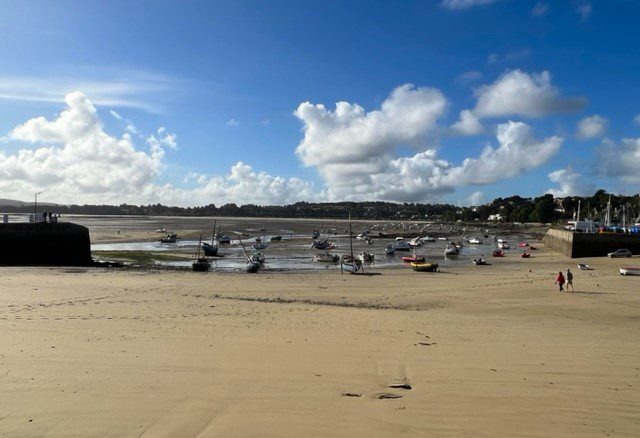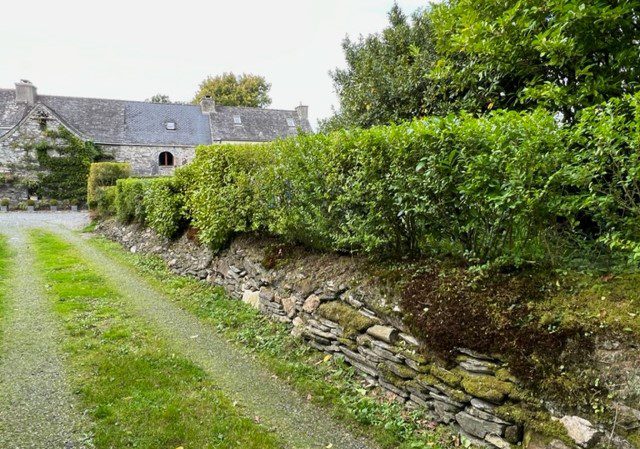In last week’s blog, I mentioned that we had a few days before we had new guests arrive. This has turned out to be nearer a couple of weeks as one of the guests who were due to stay with us was diagnosed with COVID and so, sensibly, decided not to travel. It is still out there …
It also said that we would be welcoming David’s Dad, Roger, who, thankfully, has not been diagnosed with any problems so he arrived on Tuesday for a visit.
The amount I managed to achieve with our projects was dependent on weather, which has been a really lovely start to October, and what we did with Roger. As with other family guests we do tend to go out a little more and visit, or revisit, towns and restaurants around us.
On the day Roger arrived we went back to a restaurant that David and I hadn’t eaten in since before the 2020 pandemic. It is called L’Auberge’In and is an ouvrier restaurant of which there are hundreds throughout France. ‘Ouvrier’ translates as ‘workman’ or ‘labourer’ and these restaurants exist primarily for workers to have their lunch although anyone can eat there.
As anyone who has visited France (or worked with the French) will know, lunch is a big event and is taken seriously. For workers it starts as close to noon as possible and lasts until about 1330 (or later). Ouvrier restaurants provide a filling and hearty meal for not very much money and L’Auberge’In is one of the better ones.
The menu begins with a self-service buffet with a huge choice of starters including salads, charcuteries, pate, seafood etc; followed by a choice of 1 of 5 main dishes and dessert is another self-service selection from a wide variety of options – or of course you can choose cheese. Probably either / or rather than as well as bearing in mind you only have an hour and a half!
Water is provided, obviously, but so too is wine if required and all finished with a proper coffee. You can easily feast until stuffed but be prepared for the bill – 13, 50 € each, which has rocketed by 1 € since we last ate there in 2019! Amazing.
In the days since, we have visited Morlaix again with Roger, a town we all like and definitely worth a trip if you’re in the area, and yesterday we had lunch on the coast in a town called Locquirec.


Locquirec is a very pretty little town with a number of restaurants and one that David’s Mum and Dad ate in often when they stayed. As yesterday marked David’s Mum’s birthday, we thought it appropriate to go back to one of the restaurants they ate in together. It was made especially lovely with bright sunshine and clear skies so after lunch, we decided to drive along the coast road between Locquirec and Plougasnou, another attractive little town. Looking down at some of the bays and beaches you could have thought you were in the Caribbean.


Today we went to the market at Daoulas as Roger likes to take home some of the local smoked trout but, sadly, the stall that usually sells it wasn’t there. At least we could go back to our current favourite eatery – La Faiencerie – as if we needed an excuse!
I have managed to continue with the hedge cutting and have almost reached the point I can say I don’t need to do anymore this year, and focussed on the Granary garden. When I have been cutting the hedges previously, I saw that some of the privet was dying back. After investigation we concluded that it was suffering from Honey Fungus which is bleak news.
Privet is apparently very susceptible to this fungus and, once infected, death is inevitable, and rapid. As the fungus is able to spread along the roots of the plants, it means that all of the privet will eventually die and will need to be replaced. There are now some large gaps in the hedge where some old privet plants have gone.
There is no remedy or means to get the fungus out of the soil (other than very drastic digging huge amounts out and burning) but, thankfully, there are some plants which don’t appear to suffer and one is griselinia, one of favourite hedging plants. Griselinia has many advantages, it is a lovely bright green colour, retains its leaves year-round, grows very quickly and is extremely easy to propagate.





We have pre-empted the hedge’s loss by planting some griselinia where it suffered most before and that is already growing rapidly but, we will have to some new plants to the hedge, big ones where there are now gaps and smaller ones under the privet which is still alive at the minute. Hopefully we will have a decent hedge in a couple of years.
We hope to help the hedge on one side by, eventually, making it much wider as, currently it is a narrow strip of elevated soil that gets very dry in any summer and baked in summers such as we had this year. This is another job added to the long list but will require lots of slate and soil – one I have, the other I need to source!
Roger is with us until Friday so I make the same caveat about project progress – I’ll update next Sunday.
Kenavo.
